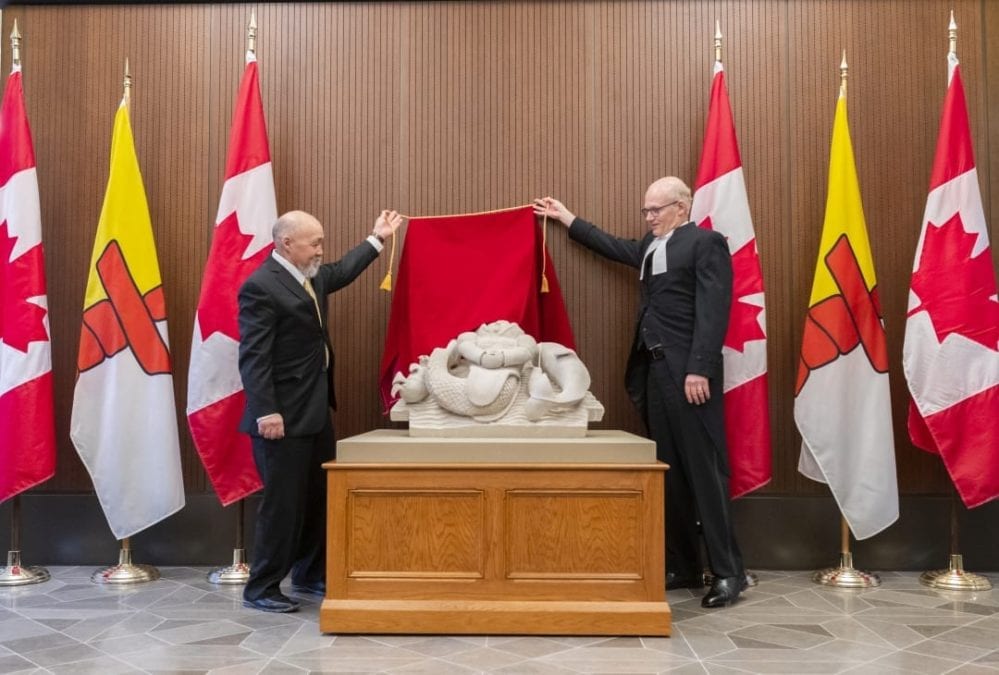Iglulik artist Bart Hanna Kappianaq, creator of a new Sedna sculpture for the 20th anniversary of Nunavut's status as a territory, received all the protocol Ottawa has to offer April 8.

photo courtesy House of Commons
The unveiling of his commissioned sculpture began with Elder Jeanie Okalik offering a prayer and lighting the qulliq, after which Speaker Geoff Regan spoke.

photo courtesy House of Commons
"When architect John Pearson designed the Parliament Building, he did so with both the past and the future in mind. This new edifice would commemorate the nation's history, but also serve as a canvas on which future generations of Canadians could leave messages of their past and their present to a Canada of tomorrow," said Regan.
"And so the Parliament Building is our stories made stone, and Mr. Hanna our newest storyteller. Mr. Hanna, you once said: 'I’m not a writer, I have to put it in the stone.' Well, a hundred years ago, Mr. Pearson wrote: 'I would rather write in stone than on paper.' I think you would have been kindred spirits."

photo courtesy House of Commons
Following throat-singing by Maatalii Okalik and Tracy Sarazin, Regan and Hanna removed the drape to unveil Sedna.
"Sedna is one of the pieces I like carving the most. Sometimes she's called Nuliajuk, Sassuma Arna or Takanakapsaaluk. She is a marine being that has been seen throughout the Arctic waters, as my grandfather said one time many years ago," stated Hanna in a news release.
"She is described as having a head and a torso similar to a human, with the bottom half of a whale, with fins and a fluke. Most stories of Sedna seem to suggest that she is benevolent; however, I have occasionally encountered comments that suggest this is not always the case. "

photo courtesy House of Commons
Hanna, who has been carving since the early 1960s, was selected by a jury that included the Dominion Sculptor, invited experts from the art community, and the Curator of the House of Commons.
"Through his art, Mr. Hanna often addresses social issues and the negative effects of colonialism on Inuit communities. By including characters that are pulled from shamanism or from his dreams, his work promotes healing, addresses his own experiences and inspires others to share and understand these issues as well," said Regan.
"Bart Hanna's artistry and his abiding love for his land have breathed life into stone; through him, Canada’s newest territory now adds its own chapter to our nation’s story, and our Parliament Buildings move closer to perfection."
This Sedna marks the anniversary of the establishment of Nunavut as a territory April 1, 1999 and is the final piece of artwork crafted as part of the House of Commons' legacy projects to commemorate the 150th anniversary of Confederation, according to the news release.
The piece, measuring 65 cm by 84 cm, is a sculptural tympanum – the sculpture which fills a semi-circular or triangular decorative wall surface over an entrance, door or window, bounded by a lintel and arch.
This new sculpture will join a series of works already housed in the Foyer, dating back to 1978, according to the release.
"At the suggestion of Wally Firth, Member of Parliament for the Northwest Territories, former Speaker of the House of Commons James Jerome initiated a sculpture program featuring Indigenous artists in 1978. The intention was to reflect the diversity of Canada's cultural heritage by incorporating Indigenous art in the architecture of Centre Block," states the release.
"The depth of the space that was chosen for the tympanum was sufficient for a high relief, which gave the artist great design flexibility."
The sculpture is to be displayed in West Block until it can take up permanent residence in the House of Commons Foyer following the rehabilitation of Centre Block.
"Mr. Hanna’s work is a contemporary art piece in a traditional medium, which I believe makes it a perfect addition to the Heritage Collection of the House of Commons," said Regan.

photo courtesy House of Commons